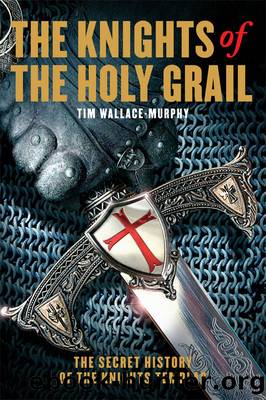The Knights of the Holy Grail by Tim Wallace-Murphy

Author:Tim Wallace-Murphy
Language: eng
Format: epub
Publisher: Watkins Media
Published: 2011-12-13T00:00:00+00:00
The Fifth Crusade
Pope Honorius III called for a new crusade which took place in 1218. The Templars, who had played no part in the previous crusade, the Fourth, were heavily involved in the Fifth Crusade. King Andrew of Hungary and Duke Leopold of Austria arrived separately in the East with their armies and attacked the key city of Damietta in Egypt. The crusaders, with reinforcements led by the King of Jerusalem, including Templars, landed at Damietta in June 1218. The city was quickly taken, despite the Christian forces being heavily outnumbered, and it was the quick and decisive action by the Templar Master that brought victory to the crusaders.28 The Templars had rapidly adapted their methods of fighting to cope with the waterlogged Nile Delta. They used a fleet of ships and pontoons and, coping with the swamps, once again proved their capability as strategists and engineers of genius.
After the capture of Damietta the Egyptian sultan offered them Jerusalem if they would return the city to his control. The papal legate, Pelagius, refused, for unless the lands surrounding Jerusalem were also returned it would be impossible to hold the Holy City. After the imperial army under Emperor Frederick II failed to arrive, Pelagius ordered the army to advance up the Nile, an action that was taken against strong advice from the Templars29 who believed that the Christian resources were already overstretched. When the crusaders reached the town of Mansurah, the Muslim army trapped them by cutting off their retreat and halting their advance by opening the sluice gates on the river, flooding the crusaders into submission. As the Templar Grandmaster later wrote in a letter to the Templar Preceptor in England, they were âtrapped like a fish in a net.â30 A truce that was to last for eight years was agreed and Damietta was surrendered.
The Holy Roman Emperor, Frederick II, with his army belatedly reached Acre in September 1228 after a delay at Otranto where many of his forces had fallen ill. This tardy progress so enraged the pope, Gregory IX, that he immediately excommunicated the emperor. Frederick was excommunicated a second time the following spring when he eventually did set sail for Acre, because he had continued the crusade while excommunicated. So, by the time he reached Acre, he was barred from leading the crusade.31 The Templars and Hospitallers supported the pope but the Teutonic Knights supported the emperor.
Frederickâs wife, the Queen of Jerusalem, died in childbirth, and thus he lost any claim to the throne of Jerusalem, except as regent for his infant son, Conrad. Thus, having lost both his crown and any authority that might have flowed from his position as leader of the crusade, he marched to Atlı¯t and demanded that the Templars hand over the castle to him to be garrisoned by his forces. The Templars refused and he then marched to Jaffa. The Templars and Hospitallers followed a day behind, having refused point blank to accept his command. Frederick eventually handed command over to his generals, and the two military orders rejoined the crusaders.
Download
This site does not store any files on its server. We only index and link to content provided by other sites. Please contact the content providers to delete copyright contents if any and email us, we'll remove relevant links or contents immediately.
The 5 Love Languages: The Secret to Love That Lasts by Gary Chapman(9557)
The Space Between by Michelle L. Teichman(6838)
Assassin’s Fate by Robin Hobb(6102)
Wiseguy by Nicholas Pileggi(5647)
Everything Happens for a Reason by Kate Bowler(4659)
Gerald's Game by Stephen King(4555)
Pillow Thoughts by Courtney Peppernell(4188)
A Simplified Life by Emily Ley(4079)
The Power of Positive Thinking by Norman Vincent Peale(3984)
Harry Potter and the Prisoner of Azkaban (Book 3) by J. K. Rowling(3293)
Resisting Happiness by Matthew Kelly(3287)
Being Aware of Being Aware by Rupert Spira(3215)
Girl, Wash Your Face by Rachel Hollis(3192)
The Code Book by Simon Singh(3055)
More Language of Letting Go: 366 New Daily Meditations by Melody Beattie(2955)
Real Sex by Lauren F. Winner(2950)
Name Book, The: Over 10,000 Names--Their Meanings, Origins, and Spiritual Significance by Astoria Dorothy(2926)
The Secret Power of Speaking God's Word by Joyce Meyer(2923)
The Holy Spirit by Billy Graham(2880)
